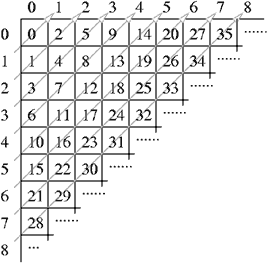 |
| ||||
Home Page
F.A.Qs
Statistical Charts
Past Contests
Scheduled Contests
Award Contest
| ||||||||||
| Online Judge | Problem Set | Authors | Online Contests | User | ||||||
|---|---|---|---|---|---|---|---|---|---|---|
| Web Board Home Page F.A.Qs Statistical Charts | Current Contest Past Contests Scheduled Contests Award Contest | |||||||||
|
Language: Polygon Encoder
Description Imagine an infinite table with rows and columns numbered using the natural numbers. The following figure shows a procedure to traverse such a table assigning a consecutive natural number to each table cell:  This enumeration of cells can be used to represent complex data types using natural numbers:
The Association of Convex Makers (ACM) uses this clever enumeration scheme in a polygon representation system. The system can represent a polygon, defined by integer coordinates, using a natural number as follows: given a polygon defined by a vertex sequence ‹(x1, y1), …, (xn, yn)› assign the natural number: L(‹P2(x1, y1), …, P2(xn, yn)›). ACM needs a program that, given a natural numbers that represents a polygon, calculates the area of the polygon. It is guaranteed that the given polygon is a simple one, i.e. its sides do not intersect. As an example of the problem, the triangle with vertices at Input The input consists of several test cases. Each test case is given in a single line of the input by a natural number representing a polygon. The end of the test cases is indicated with Output One line per test case, preserving the input order. Each output line contains a decimal number telling the area of the corresponding encoded polygon. Areas must be printed with 1 decimal place, truncating less significative decimal places. Sample Input 2141 206 157895330 * Sample Output 1.0 0.5 1.0 Source |
[Submit] [Go Back] [Status] [Discuss]
All Rights Reserved 2003-2013 Ying Fuchen,Xu Pengcheng,Xie Di
Any problem, Please Contact Administrator